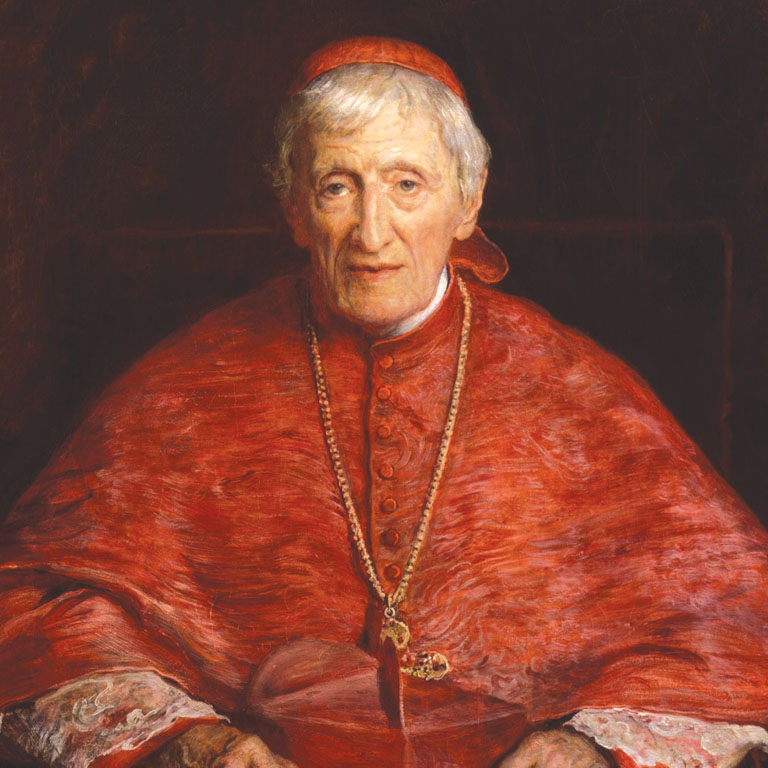Papieska Akademia Teologiczna, W Krakowie, Wydzial Filozoficzny, Manuscript, Kraków 2007, p. 147. Summary in english
Summary
Recently P. Gröning has released a very interesting film, in which he attempted to get to the very roots of European culture. For six months he lived among the monks of the Grand Chartreusse monastery. Through his camera we can peep into the cloister, somehow sharing with the monks the silent way of their religious everyday life. We can witness their private prayer and listen to their common Gregorian chants. Into Great Silence invites us to experience what is the most fundamental in life of faith. We almost overhear the human logos as it transcends toward the Unspeakable.
When I was studying John Henry Newman’s writings on faith I found the same fascination for that phenomenon. In my dissertation entitled Transcending language towards Unspeakable (Philosophy of faith of J. H. Newman) I concentrated on the question: how – according to Newman – does the language of faith transcend to what cannot be spoken of? This difficult subject, though one of the most crucial in Newman’s philosophy, has rarely been treated. Nevertheless we might well realize the importance of it, when we read the words of his epitaph, suggested by himself: ex umbris et imaginibus in veritatem.
These words show how deeply he was immersed in the great European tradition of philosophical thought, which might be called phronesis tradition. As M. K. Tillman has pointed out, its beginnings may be traced up to the great poem of Parmenides, in which the young inquirer is guided by the Goddess all the way to the limits of his mind. There she reveals to him the motionless heart of well-rounded truth, wherein to think and to be are one and the same. On his journey back he experiences the complex cosmos where light and darkness mix, where opposites harmonize and clash, where partial understandings seem to rule the day. This represents the leitmotif of the phronesis tradition, which through Plato, Aristotle, Clement and Origen came down to Newman: human logos relentlessly moves from a notion to a notion, from unity to variety, from a shadow (skia) to an image (eikon), but never ceases the pursuit of truth, until it finally finds itself embraced by it.
In the first, introductive chapter I show that this phronesis tradition principle applies to Newman’s phenomenology of faith, which might be deciphered from his famous poem Lead, Kindly Light. The basic experience of true faith is a total reliance upon providential guidance, a humble acceptance of a veil contained in all revelation, and a readiness to transcend the human logos towards the Eternal Logos. In Newman’s theology this Logos is the safeguard of all meaning in faith:
Take away this Light and we are utterly wretched, – we know not where we are, how we are sustained (…), why we are in being. But with it we have all and abound[1].
And this theological stance gives way also to Newman’s philosophical conviction on an in-absolute and economical status of all human words, knowledge and endeavours:
What is it to us whether the knowledge He gives us be greater or less, if it be He who gives it? What is it to us whether it be exact or vague, if He bids us trust it? What have we to care whether we are or are not given to divide substance from shadow, if He is training us heavenwards by means of either?[2]
I distinguish three contexts of Newman’s stance on the subject of the transcending language of faith. In the second and third chapters I discus his two different approaches: first, enacting platonic relation between the Christian Idea which is unspeakable, living and ever inspiring new economies of human logos, he interprets the later as an expression of aspects of the former. In the second approach, Newman more or less refers to St. Thomas Aquinas, and indirectly to Aristotle’s epistemology, he analyses the logos of faith as a variety of complimentary economies (approximate narratives) that bring us closer to the Incomprehensible. Both analyses are very interesting and important, but the most surprising analysis for those who have studied only Newman’s University Sermons and Grammar of Assent, is the fourth chapter, in which I attempt to prove his repeated turning towards poetry. The logos of faith is originally poetical, or rather as postulated in Newman’s Benedictine Essays the basic mood (attitude) of an existence out of faith should be poetical.
Thus Newman opposes the rationalistic view on the language of faith, that he named liberalism. This view assumes that we may ensure enough distance to our religious narratives to compare them with the real state of things or at least to assess their probability. As we cannot know “the reality” we have to use any criterion to choose between them but the truth. It may be practical, aesthetical, cultural, historical etc. We are obliged to seek the truth, but in fact we are unable ever to catch it. Since many various religious narratives seem to contradict each other, we should not bother about dogmatic claims to dominate but welcome every narrative on the market of equally profitable tales. The same line of thought is represented nowadays by a contemporary postmodern religion which celebrates freedom of choice. We may change our tales as often as we wish. This attitude is allegedly the only alternative to religious fundamentalism.
Newman in his criticism of this rationalistic view anticipated modern debate on the place and structure of language of faith. His two-fold answer to the liberalistic claim contained in a note from Philosophical Notebook entitled On economical representation and in a letter with the title On economy and reserve dispels the utopia of possibility of an epistemological distance to our faith narratives. In fact, they do constitute what we call “the state of things” and we cannot compare them with some more relevant reality, as we cannot also grasp the economical reference of sense data to so called reality. However, the economical faith narratives as all human theories might come to contradict each other, when driven by an intellect to their limits, this happens, not because they are false and we could replace them by more accurate, but because as always partial and incomplete they prove to be, what they have been from the beginning – human economies of logos. The economical structure of faith narratives is indispensable to our human condition, in which we see things “like a dim image in a mirror” (in aenigmate) and not “face to face”. We wander through this earth as pilgrims ex umbris et imaginibus to find ourselves one day in veritate.
What then about dogma? What kind of utterance is it? Theology is – according to Newman – a necessity for real religion, but it deals with notions and inference which are comprehended notionally. We might assent to the propositions of our symbols (dogmas) separately, but we cannot join them together in one real image. Thus dogmas – Newman seems to say – are a kind of grammar for the language of faith. Whatever the case, he distinguishes between two modes of epistemological approach towards religious propositions: scientific and poetical. The first approach wants to comprehend and utilize things known. The second one sits down at feet of the Unspeakable to listen. As I show in my fourth chapter, Newman finds the source of every doctrinal statement in the living faith of the Church. It acknowledges its narratives as told by the Eternal Logos. That is why our symbols (even in the most dogmatic form as p. e. Athanasian Creed) are originally “lays of love”, “songs of praise” and “warnings of a battle signal”. Although they might become a subject for scientific investigation, they are primarily poetical hymns sang in a poetical mood of reliance upon the Word.
In spite of lapse of time and so many studies of Newman’s thought (since 1980-ies in the bibliography on his thought one can find over thousand items) we should not be misled to conclude that he has no more to offer to the contemporary philosophy of faith. In the last chapter I try to point out some interesting antecedents in his considerations of modern debate. First of all his debt to the British empiricism brings him closer to the analytic school. It occurs that even in his treatment of questions on the epistemological status of senses in relation to the so-called state of things, Newman anticipates Wittgenstein’s Investigations. Let alone when the author of Philosophical notebook looks at science as setting “rules of the game”. The same awareness of respect to the Unspeakable may be a good point of comparison. There is, secondly, some proximity of Newman’s descriptions with the phenomenological tradition. After the book of K. Tarnowski To hear Unseen I discern prospects of comparative research with such philosophers as M. Heidegger, A. Heschel, P. Ricoeur, A. Vergot, J. Ladriere. Last but not least, I find some challenge in looking at Newman from a postmodern perspective. Of course it deserves some appreciation that Newman in his lifelong criticism of liberalism foresaw the coming of postmodern condition in the domain of religion. But most of all he is very postmodern, or rather ever-modern, in his faithfulness to phronesis tradition, in putting an accent on the constant evading movement of meaning in every text, and in finding omnipresent difference (une petite la). Simultaneously, he challenges postmodernism, when he attempts to reveal the allegorical structure of the logos of faith, though ever eluding in its sense, yet always in effort to point at what is de hors-text.
Finally, we should not forget the specific feature of all Newman’s thought. It is constantly rhetoric. He always seems to glance at his listeners, relevantly change the tone of his voice, and recede as Socrates from offering ready answers. It is as if he found some pleasure in showing us gaps and fissures of all our discourse and then asking us: Que voulez vous? This is why he is so “upsetting” and intriguing to contemporary philosophers. And I hope that my dissertation does not diminish this “mission” of Newman who focused on the logos of faith, ever eluding philosophical analysis and ever transcending to Unspeakable and thus at last falling into Great Silence.
[1] PS, vol. 2, p. 215.
[2] US, p. 348.


Leave a Reply